There are days when one needs to, at least mentally, raise the arms, flatten the hands, and form them into a “T” in the air. Taking a step back, when needed, is an essential part of maintaining perspective, sanity (relative to what one still has!), and energy, but it is also something that only the individual in question can trigger at the right moment. We all have our limits and they often do not show on the outside, to allow others to call a timeout for us.
Earlier this week, I had to step away from work, and get myself back on track. For me, this means only putting in a flat 8-hours of work, for the day! Fortunately, I am blessed to have amazing recreational destinations well within reach. On this occasion, I returned to a spot that I had not fished since late last year, but which is a relatively close drive.
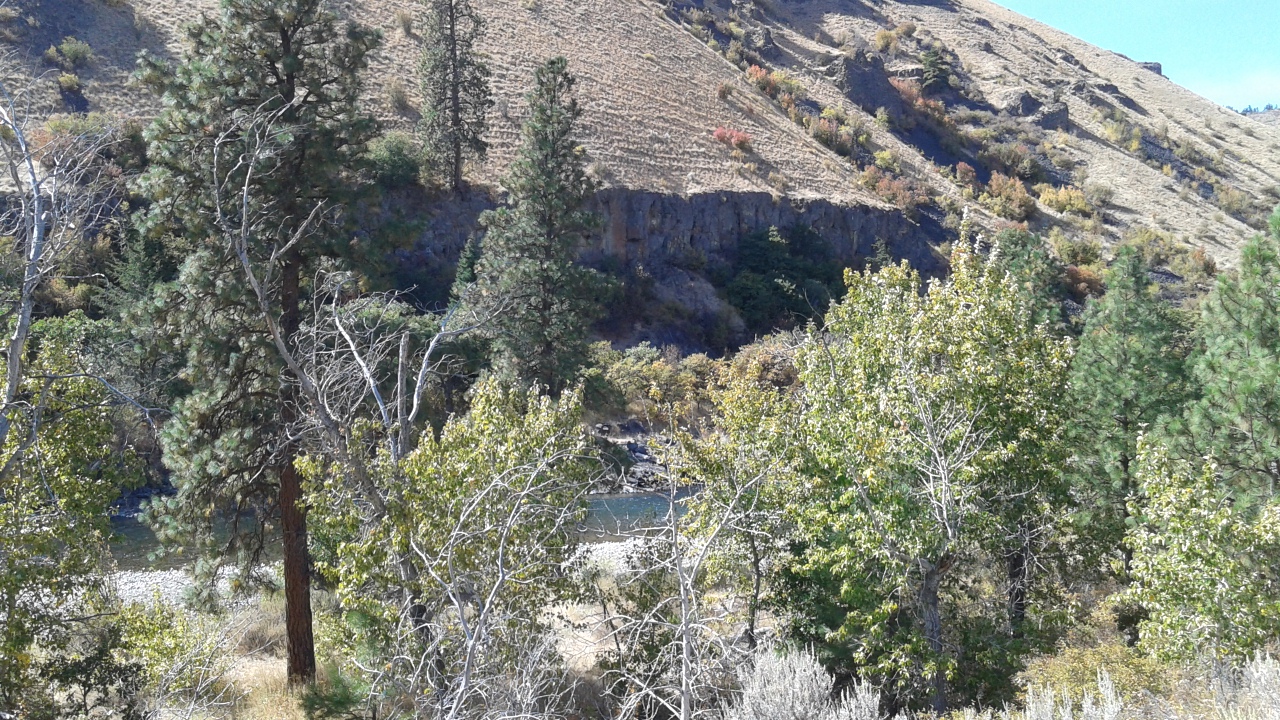
While driving out, you see the river snaking through the canyon, glistening in the corner of your vision the majority of the time. In spring and summer, much of it is simply too powerful to offer the kind of fishing I enjoy, or even a safe wade. The Naches gets fed by several smaller rivers, and boasts quite a flow, when in full swing. The spot in question is upstream of the inflow of the largest contributor, so it calms a bit more quickly as the season progresses, but it was still roughly 300 cfs, when I got there. It is also at a lower altitude than my usual places, so I had the full benefit of the 70-degree day, despite a bit of a fluctuating breeze.
I geared up in a spot that has a high overlook, and was reminded at once of how nicely that section of the canyon was filled in with trees and larger bushes, this time of year. Despite being able to make out various sections of the water, I knew that, once at the water, the sound of it on the riffles and in narrow sections, coupled with the distance and elevation change, would all but block out even the loudest road noises.
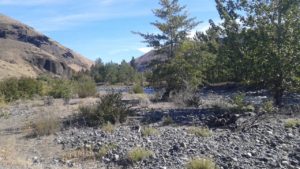
Properly set up, and with my #14 Stroby tied on, I made my way downstream, keeping well back from the water. The layout of this section, in a macro sense, does not seem to change very much. I put in at the upper third of a long set of riffles, move through a wide run, approach a cascading narrow section, then a fast-moving run, another cascading narrow, then a pool with a wide riffle above it. Barring anything unexpected, I can count on this being 1.5 – 1.75 hours of fishing, at my normal pace.
As I stepped into the cool water (no, I did not remember to take the temp!) I am first struck by the power of this river. I get very used to the <50cfs waters on the small tributaries, so even a wide section at this flow has quite a push. When that initial, instinctive response (Am I getting washed away??) had run it’s course, and my feet confirmed that they were, in fact, staying put, I took a moment to just draw a deep breath, listen to the water and insects, and feel the cool flow around my legs and the sun on my left.
Great day to be on the water.
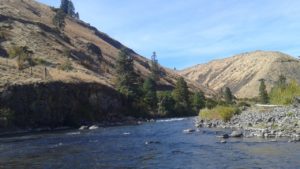
Slowly moving upstream, I got in several practice casts, getting used to the breeze of the day. Within a few steps, I was in sync and dropping my flies…mostly…where I wanted them. I ran my standard pattern as I worked across the easily reachable width I was focused on. I seem to pick up and recast with perhaps more frequency than some other fly fishers, perhaps because I feel the need to wade farther out and end up casting fairly directly upstream. I pick a likely spot, then cast below it, to one side, then the other, then in front…then move on to the next likely spot. Rarely to I let the fly drift back more than the 9′ of leader, based on it’s original landing spot. Casting so close to directly upstream, any more drift would put the fly through the same water where the end of the fly line landed, on the initial cast, so I assume any fish that far back would already be “lined” and not likely to be showing interest. Once I cover a fan of likely spots, I move forward maybe 3-5′, then do this again. The theory being that the fly will continue to land in waters that have not been previously disturbed, and where the fish has not seen me or my line, yet.
The top third of the riffles provided no signs of interest in the fly, and I debated swapping it out as I went on. As I cleared that, moving into the long run, I focused on the right bank, where larger rocks were offering some shelter for wayward fish…I hoped. Only a faint sign of interest in this area; probably from young, overly exuberant specimens that have not yet figured out how precarious their lives can be, without due caution.
Moving farther up, I can to a spot even with a large rock, roughly 2/3 of the way across the river. On the near side, this section has a few medium rocks just under the surface, as well as a good drop-ff and trough to work along. It was among these medium rocks that I hooked my first of the day! Perhaps 5-6″, but at least I knew I was not going to get skunked!
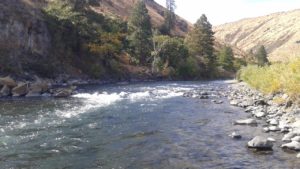
I switched to a light-body #12 Parachute Adams, as I got closer to the first of the cascading narrow sections, knowing that the Stroby would not have the visibility I would need in this rough water, and started working the near-side seam line and the clumps of submerged rocks. A couple of splashy refusals told me that the fish were there, and looking skyward, but not ready to take it. Enjoying the cat-and-mouse, I continued slowly advancing, until I was casting into a narrow triangle of still water, between the right edge of the whitewater, the large and protruding rocks on the right, and the upstream side of a broad, flat rock that was slightly downstream. It looked like a great hollow in the river bottom, and certainly should have been “fishy.” I saw no interest…until the fly drifted back over the flat, submerged rock.
As the fat body of the Parachute Adams cleared the downstream side of the submerged rock, a green-backed rocket shot out of the water, swallowing the fly as it passed through the surface film! In a section with such a concentrated flow, any fish is going to feel larger than it is, but this one had a very nice feel to it, as I worked back and closer to the side. It did a great job of trying to stay in the fastest current, but was not large enough to snap off the leader, in the end.
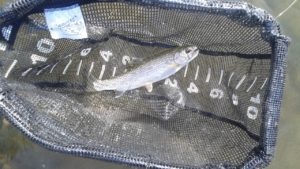
What a pretty fish! Had it cooperated with my instructions to stay still and in line with the measurements, it would have shown in at, or just under 11″! Fly removed and fish released, I cast a few times and found that the Parachute Adams had gotten a bit too slimy, and needed to retire for the day. I put the Stroby back on, and continued to work my way up to and through the narrows, catching another, smaller fish as I went. The faster run, above this area yielded no signs of interest, as did the pool above the rapids at it’s head. I spent some time casting to the base of the riffles that fed this pool, and enjoying the increasing breeze, before finally reeling in, clipping off the fly, and heading back to the truck.
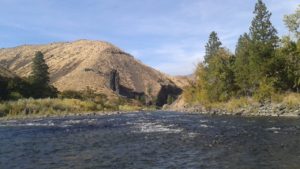
An altogether beautiful day. The water, although certainly calming down from the peak of it’s flow, could still do with just a little bit less volume. Perhaps I will try another tributary, next time…or perhaps not.
Tight lines.
